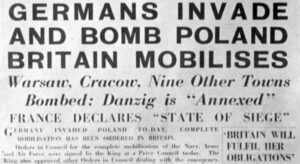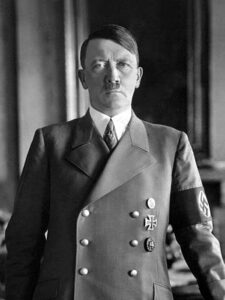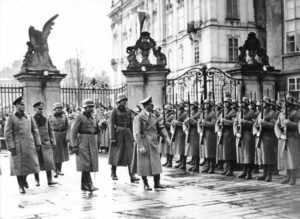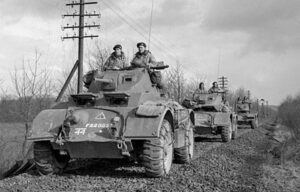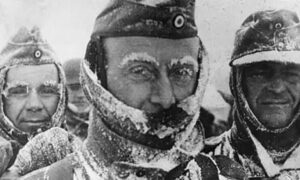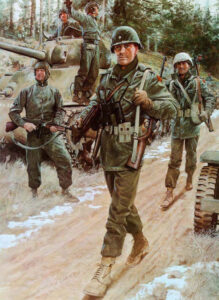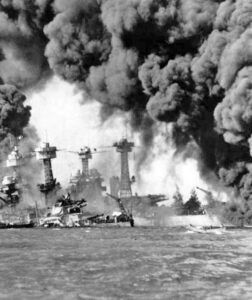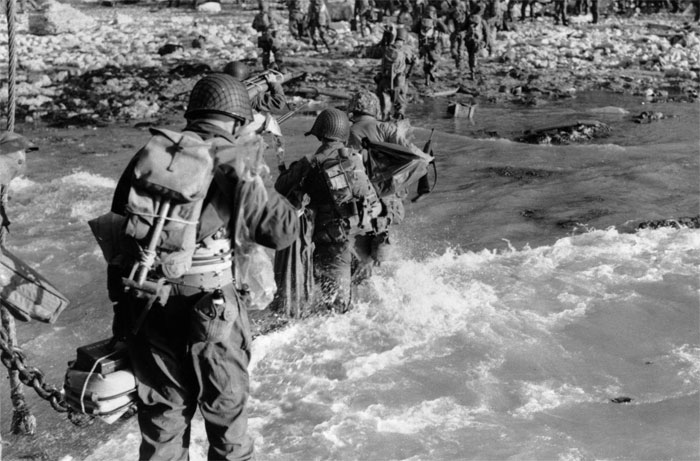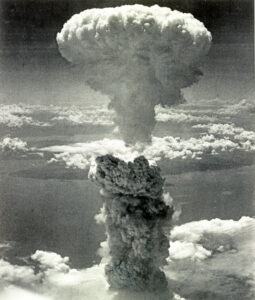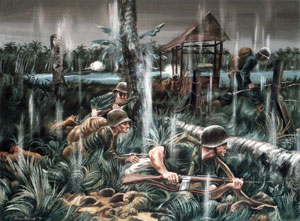World War II was the largest and most violent armed conflict in the history of mankind, involving more than 30 countries. The 1939 Nazi invasion of Poland sparked the war for six bloody years until the Allies — France, Britain, the U.S., the Soviet Union, and China — defeated the Axis powers of Nazi Germany, Japan, and Italy in 1945. Some 70 nations took part in the conflict, and fighting took place on the continents of Africa, Asia, and Europe, as well as on the high seas.
Political and economic instability in Germany, combined with bitterness over its defeat in World War I and the harsh conditions of the Treaty of Versailles, allowed Adolf Hitler and the Nazi Party to rise to power. In the mid-1930s, Hitler began secretly to rearm Germany, violating the treaty. He signed alliances with Italy and Japan to oppose the Soviet Union and intervened in the Spanish Civil War in the name of anti-communism.
The War in Europe
World War I left the question of who would dominate Europe unresolved. The tremendous dislocations caused by the war laid the groundwork for the collapse of democratic institutions there and set the stage for a second German attempt at conquest. A worldwide depression that began in 1929 destroyed the fragile democratic regime in Germany. In 1933 Adolf Hitler led to power the National Socialist German Workers’ (Nazi) Party, a mass movement that was virulently nationalistic, antidemocratic, and anti-Semitic. He ended parliamentary government, assumed dictatorial powers, and proclaimed the Third Reich. The Nazi government increased the strength of the German armed forces. It sought to overturn the Versailles Treaty, recover German territory lost at the peace settlement, and return to the so-called Fatherland German-speaking minorities within the borders of surrounding countries.
The ultimate goal of Hitler’s policy was to secure “living space” for the German “master race” in Eastern Europe. An instinctive gambler, Hitler relied on diplomatic bluff and military innovation to overcome Germany’s weaknesses. He played skillfully on the divisions among the European powers to achieve many of his aims without war. With the Italian Fascist dictator Benito Mussolini, he announced a Rome-Berlin alliance (the Axis) in 1935. Meanwhile, in the Far East, the Japanese, the only Asian industrial power, coveted the natural resources of China and Southeast Asia but found their expansion blocked by European colonial powers or by the United States. Having seized Manchuria in 1931, they began a war against China in 1937. The League of Nations failed to counter effectively Japanese aggression in Manchuria and an Italian invasion of Ethiopia. Soon, Germany, Italy, and Japan became allies, facing Western democratic governments that wanted to avoid another war and the Soviet Union, whose Communist government was widely distrusted.
After World War I, the people of the United States, having rejected the Versailles Treaty and the Covenant of the League of Nations, remained largely indifferent to most international concerns. They firmly discounted the likelihood of American involvement in another major war, except perhaps with Japan. Isolationist strength in Congress led to the passage of the Neutrality Act of 1937, making it unlawful for the United States to trade with belligerents. American policy aimed at continental defense and designated the Navy as the first line of defense. The Army’s role was to be the nucleus of mass mobilization. This would defeat invaders who fought past the Navy and the nation’s powerful coastal defense installations. The National Defense Act of 1920 authorized an army of 280,000, the largest in peacetime history. However, until 1939, Congress never appropriated funds to pay for more than half of that strength. Most of the funds available for new equipment went to the fledgling Air Corps. Throughout most of the interwar period, the Army was tiny and insular, filled with hard-bitten, long-serving volunteers scattered in small garrisons throughout the continental United States, Hawaii, the Philippines, and Panama.
Yet innovative thinking and preparation for the future took place in the interwar Army. Experiments with armored vehicles and motorization, air-ground cooperation, and the aerial transport of troops came to nothing due to a lack of resources and consistent high-level support. The Army did, however, develop an interest in amphibious warfare and in related techniques that the U.S. Marine Corps was then pioneering. By the outbreak of war, the Signal Corps was a leader in improving radio communications, and American artillery practiced the most sophisticated fire direction and control techniques in the world. In addition, war plans for various contingencies were drawn up, as were industrial and manpower mobilization plans. During the early 1930s, Colonel George C. Marshall, assistant commandant of the Infantry School at Fort Benning, Georgia, had earmarked several young officers for leadership positions. Despite such preparations, the Army was unready for the war in Europe on September 1, 1939.
The Outbreak of War
In March 1938, German troops occupied Austria, incorporating it into the Reich. In September, Hitler announced that the “oppression” of ethnic Germans living in Czechoslovakia was intolerable and that war was near. England and France met with Hitler (the Munich Pact) and compelled Czechoslovakia to cede its frontier districts to Germany to secure “peace in our time.” Peace, however, was only an illusion. In March 1939, Hitler seized the rest of Czechoslovakia by force of arms and then turned his attention to Poland. Although Britain and France had guaranteed the integrity of Poland, Hitler and Josef Stalin, dictator of the Soviet Union, signed a secret, mutual non-aggression pact in August 1939. With the pact, Stalin bought time to build up his strength at the expense of Britain and France, and Hitler gained a free hand to deal with Poland. World War II began when Hitler’s army invaded Poland on September 1, 1939.
While German forces overran western Poland, Soviet troops entered from the east to claim their portion of that country. France and Britain declared war on Germany and mobilized their forces. The subsequent period of deceptive inactivity, lasting until spring, became known as the Phony War. Nothing happened to indicate that World War II would differ significantly in style or tempo from World War I.
However, the years since 1918 have brought significant developments in the use of tanks. Several students of war — the British Sir Basil Liddell Hart and J. F. C. Fuller, the Frenchman Charles de Gaulle, the American George S. Patton, and the Germans Oswald Lutz and Heinz Guderian believed that armored vehicles held the key to restoring decision to the battlefield. However, only the Germans conceived the idea of massing tanks in division-size units, with infantry, artillery, engineers, and other supporting arms mechanized and all moving simultaneously. Moreover, only Lutz and Guderian received enthusiastic support from their governments.
In the spring of 1940, their theories were tested as German forces struck against Norway and Denmark in April, invaded the Netherlands, Belgium, and Luxembourg in May, and broke through a hilly, wooded district in France late in the same month. Their columns sliced through the English Channel, cutting off British and French troops in northern France and Belgium. The French Army, plagued by low morale, divided command, and primitive communications, fell apart. The British evacuated their forces from Dunkerque with the loss of most of their equipment. The Germans entered Paris on June 14, and the French government, defeatist and deeply divided politically, sued for an armistice. The success of the German Blitzkrieg forced the remaining combatants to rethink their doctrine and restructure their armies.
With his forces occupying northern France and a French puppet government established in the south, Hitler launched the Luftwaffe against the airfields and cities of England. This was to pave the way for an invasion. Britain’s survival hung by a thread. From July to October 1940, while German landing barges and invasion forces waited on the Channel coasts, the Royal Air Force, vastly outnumbered, drove the Luftwaffe from the daytime skies in the legendary Battle of Britain. With increasing American cooperation at sea, the British Navy fought a desperate battle against German submarine packs to keep the North Atlantic open. British pugnacity finally forced Hitler to abandon all plans to invade England.
In February, Hitler sent troops under Lieutenant General Erwin Rommel to aid the Italians fighting against the British in North Africa. German forces coming to the aid of the Italians in the Balkans routed a British expedition in Greece, and German paratroopers seized the strategic island of Crete. Then, in June 1941, Hitler turned against his supposed ally, the Soviet Union, with the full might of the German armed forces.
Armored spearheads thrust deep into Soviet territory, driving toward Leningrad, Moscow, and Ukraine and cutting off entire Soviet armies. Despite tremendous losses, Russian military forces withdrew further into the country and continued to resist. Nazi expectations of a quick victory evaporated, and the onset of winter caught the Germans unprepared. Their advance halted 30 miles from Moscow, and the Soviets launched massive counterattacks.
The Germans withstood the counterattacks and resumed their offensive the following spring. The Soviets, now locked in a titanic death struggle, faced the bulk of the German land forces, over 200 divisions. The front stretched for 2,000 miles, from the Arctic Circle to the Black Sea. Soon, casualties ran into the millions. Waging war against the implacable brutality of totalitarian regimes, both sides committed wholesale atrocities- mistreatment of prisoners of war, the enslavement of civilian populations, and, in the case of the Jews, outright genocide.
In the United States, preparations for war moved slowly. General George C. Marshall took over as Chief of Staff in 1939, but the Army remained hard-pressed to defend the continental United States. Defending overseas possessions like the Philippines seemed a hopeless task. In early 1939, prompted by fears that a hostile power might be able to establish air bases in the Western Hemisphere, thus exposing the Panama Canal or the continental United States to aerial attack, President Franklin D. Roosevelt launched a limited preparedness campaign. The power of the Army Air Corps increased; Army and Navy leaders drafted a revised series of war plans to deal with the threatening international situation. The focus of military policy changed from continental to hemisphere defense.
After the outbreak of war in Europe, the president proclaimed a limited emergency and authorized increases in the size of the Regular Army and the National Guard. Congress amended the Neutrality Act to permit munitions sales to the French and British. Large orders from them stimulated retooling and laid the basis for future war production expansion. The Army concentrated on equipping its regular forces as quickly as possible and, in 1940, held the first large-scale corps and army maneuvers in American history. The rapid defeat of France and the possible collapse of Britain dramatically accelerated defense preparations. Roosevelt directed the transfer of substantial World War I munitions to France and Britain in the spring of 1940. He went further in September when he agreed to transfer 50 over-age destroyers to Britain in exchange for bases in the Atlantic and Caribbean. In March 1941, Congress repealed some provisions of the Neutrality Act. Passage of the Lend-Lease Act, which gave the President authority to sell, transfer, or lease war goods to the government of any country whose defenses he deemed vital to the defense of the United States, spelled the virtual end of neutrality. The President proclaimed that the United States would become the “arsenal of democracy.” In the spring of 1941, American and British military representatives held their first combined staff conferences to discuss strategy in the event of active U.S. participation in the war, which seemed increasingly likely to include Japan and Germany. The staff agreed that if the United States entered the war, the Allies should concentrate on the defeat of Germany first. The President authorized active naval patrols in the western half of the Atlantic, and in July, American troops replaced British forces guarding Iceland.
Meanwhile, General Marshall and Secretary of War Henry L. Stimson made plans to expand the Army to 1.5 million men. On August 27, 1940, Congress approved inducting the National Guard into federal service and calling up the reserves. A few weeks later, lawmakers passed the Selective Service and Training Act, the first peacetime draft in American history. By mid-1941, the Army had achieved its planned strength, with 27 infantry, five armored, two cavalry divisions, 35 air groups, and a host of support units. But it remained far from ready to deploy overseas against well-equipped, experienced, and determined foes.
The United States Entered the War
On December 7, 1941, while the German armies were freezing before Moscow, Japan suddenly pushed the United States into the struggle by attacking the American naval base at Pearl Harbor, Hawaii, and the Philippines. The day after the attack, Congress declared war on Imperial Japan with only a single dissenting vote. On December 11, Hitler declared war on the United States.President Franklin Roosevelt called on Congress to immediately and massively expand the armed forces. However, two years of neglect and indifference could not be overcome in a few days.
The war became global when the other Axis powers declared war on the U.S. Japan quickly invaded and occupied most of Southeast Asia, Burma, the Netherlands East Indies, and many Pacific islands. After the crucial U.S. naval victory at the Battle of Midway (1942), U.S. forces began advancing up the islands’ chains toward Japan.
Helpless as American garrisons in the Pacific fell to the Japanese in the spring of 1942, military leaders in Washington worked feverishly to create a headquarters. This would enable them to direct a distant war effort and turn the fledgling ground and air units into viable, balanced fighting forces. In early 1942, the Joint Chiefs of Staff emerged as a committee of the nation’s military leaders to advise the President and coordinate strategy with the British. In March, the War Department General Staff was reorganized, and the Army was divided into three major commands: the Air Forces, Ground Forces, and Service Forces. Thirty-seven Army divisions were in some stage of training, but only one was fully trained, equipped, and deployable by January 1942. Army planners of the time estimated that victory would require an Army of nearly nine million men organized into 215 combat divisions, estimates that proved accurate regarding overall manpower but too ambitious for the 90 divisions that eventually were established and supported on far-flung battlefields.
Lieutenant General Lesley J. McNair, head of the Army Ground Forces and an ardent advocate of mobile war, oversaw the development of armored and airborne divisions. He also directed the restructuring existing organizations, turning the old World War I “square” division based on four infantry regiments into a lighter, more maneuverable triangular division with three infantry regiments. A severe and continuing shortage of Allied shipping space placed absolute limits on the size and capabilities of Army units. New tables of organization stressed leanness and mobility, sometimes at the expense of fighting power and endurance. Lodging, training areas, and equipment were all in short supply. American industry had to support the nation’s Allies and its military expansion. Britain needed large amounts of munitions and equipment, and lend-lease aid, including tens of thousands of trucks and other vehicles and equipment, played an instrumental part in mechanizing the Soviet Army. Amphibious warfare required large numbers of landing craft and support vessels. The first U.S. troops arrived in the British Isles in January 1942, but nearly a year passed before they were called into action against the Axis. Meanwhile, air power provided virtually the only means for the Allies to strike Germany. The Royal Air Force began its air offensive against Germany in May 1942, and on July 4, the first American crews participated in air raids against the continent.
Early in 1942, British and American leaders reaffirmed the priority of the European theater. General Marshall argued for an immediate buildup of American forces in Great Britain and a possible diversionary attack on the continent in the fall. The United States and its Allies halted Japanese expansion at the Battle of Midway in June 1942 and other campaigns in the South Pacific.
The British and Americans defeated Italian and German forces in the North Africa campaigns by 1943. The Allies then invaded Sicily and Italy, forcing the overthrow of the Fascist government in July 1943, though fighting against the Germans continued in Italy until 1945. In the Soviet Union, the Battle of Stalingrad in 1943 marked the end of the German advance, and Soviet reinforcements in large numbers gradually pushed the German armies back.
The massive Allied invasion of Western Europe began with the Normandy Campaign in western France in 1944, and the Allies’ steady advance ended with the occupation of Germany in 1945.
After Soviet troops pushed German forces out of the Soviet Union, they advanced into Poland, Czechoslovakia, Hungary, and Romania. They had occupied the eastern third of Germany by the time the surrender of Germany was signed on May 8, 1945.
In the Pacific, an Allied invasion of the Philippines in 1944 was followed by the victorious Battle of Leyte Gulf and the costly Battles of Iwo Jima and Okinawa in 1945. The U.S. dropped atomic bombs on Hiroshima and Nagasaki in August 1945, and Japan surrendered on September 2, ending the war.
Aftermath
The United States emerged from the war with global military commitments that included the occupation of Germany and Japan and the oversight of Allied interests in liberated areas. Almost 13 million Americans were in uniform at the war’s end; over eight million were soldiers. But the impulse was strong to follow past patterns and dismantle this force. Families pressed the government to “bring the boys home,” and soldiers overseas demanded acceleration of the separation process. American monopoly of the atomic bomb seemed to provide all the power that American security interests needed. Some air power advocates even argued that the bomb made armies and navies obsolete.
President Roosevelt died in April 1945, on the eve of victory. The new president, Harry S. Truman, and his advisers tried to resist the political pressures for hasty demobilization. Truman wanted to retain a postwar Army of 1.5 million, a Navy of 600,000, and an Air Force of 400,000. However, neither Congress nor the American public was willing to sustain such a force. Within five months of the victory over Japan, 8.5 million servicemen and women had been mustered out. In June of the following year, only two full Army divisions were available for deployment in an emergency. By 1947, the Army numbered a mere 700,000 — sixth in size among the world’s armies.
Yet too much had changed for the Army to return to its small, insular prewar status. Millions of veterans now remember their service with pride. The beginning of the Cold War, especially the Berlin blockade of 1948, dramatically emphasized the need to remain strong. The Army had become too deeply intertwined with American life and security to be reduced again to a constabulary force. Moreover, the time was not far off when new conflicts would demonstrate the limits of atomic power and prove that ground forces were as necessary as they had been in the past.
World War II killed more people, involved more nations, and cost more money than any other war in history. A total of 70 million people served in the armed forces during the war, and 17 million combatants died. Civilian deaths were even more significant. At least 19 million Soviet civilians, 10 million Chinese, and six million European Jews died during the war. The war cost the United States a million casualties and nearly 400,000 deaths. In both domestic and foreign affairs, its consequences were far-reaching. The war ended the Great Depression and unemployment and dramatically expanded the government’s presence in American life.
Compiled and edited by Kathy Alexander/Legends of America, updated March 2024.
Also See:
War & Military in the United States
War & Military Photo Galleries
Sources:
Digital History
Encyclopedia Britannica
U.S. Army Center of Military History


